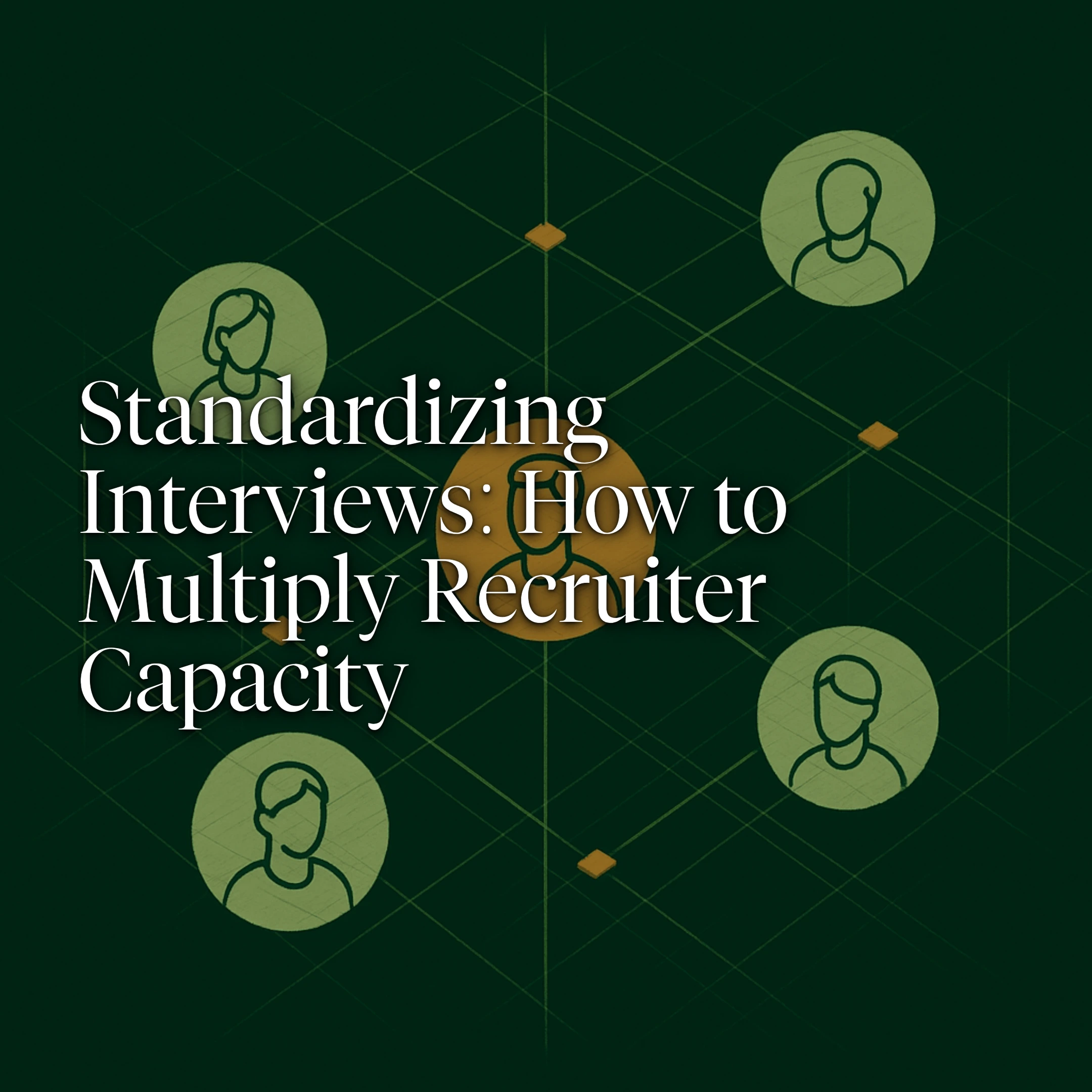How to Assess Technical Skills in an Interview: Guide for Non-Technical Recruiters
.webp)
You don’t need to be able to code to hire engineers. But you do need a system that turns vague job requirements into measurable criteria. This approach will empower you to screen confidently without becoming a technical expert yourself.
Most technical hiring processes rely on gut feel, inconsistent interviews, and endless back-and-forth with hiring managers who can’t articulate what they actually need. That wastes your time, slows hiring, and lets strong candidates slip through while weaker ones advance.
This guide gives you a repeatable framework: translate job descriptions into scorable competencies, automate initial screening, run structured interviews with evidence-based rubrics, and make defensible decisions with hiring managers. No coding required.
1. Map the Role and Core Competencies
Translate the job description into a skills matrix you can actually screen against. Many job postings are wish lists written by hiring managers who haven’t recruited before. Your goal is to turn that chaos into something actionable.
Pull every requirement from the posting and ask two questions:
- Does this task drive day-one success or is it future-growth potential?
- Where will this skill show up: in week 1, month 3, or year 1?
Anything that lands in week 1 becomes a must-have, and everything else is nice-to-have. This approach mirrors structured competency frameworks, like Korn Ferry’s methodology.
Ignore resume buzzwords completely. Phrases like “micro-service expert” tell you nothing measurable. Instead, group job requirements into three technical categories that actually matter:
- Language syntax and fundamentals: Can they write clean, working code in the required language?
- Debugging and troubleshooting capabilities: How do they identify and fix problems when things break?
- System or architectural design knowledge: Do they understand how different parts of an application fit together?
If a bullet in the job description doesn’t fit one of these, it’s probably fluff.
Collaboration is key. Loop in the technical lead for a 15-minute screen-share. They can sanity-check skill priorities, suggest proficiency levels, and point you to resources like SFIA’s role-based skill profiles. Their input keeps the matrix grounded in real project work rather than guesswork.
Here’s a sample matrix for a front-end engineer that you can adapt and drop into your ATS. While the time-based evidence columns (e.g., “Evidence in Week 1,” “Evidence in Month 3”) are an internal tool rather than an industry standard, they guide evaluation and onboarding processes.
This matrix transforms abstract requirements into concrete checkpoints you can score. It gives every interviewer a shared language for what “qualified” actually looks like.
2. Build a Structured, Bias-Free Rubric
Relying on gut feel during technical interviews is risky. A structured rubric turns every interview into a repeatable process: same criteria, same scale, clear evidence. Clarity up front reduces subjective drift and makes interviews defensible in audits.
Start by listing 4 to 6 must-have competencies. For a front-end role, you might choose HTML/CSS, React state management, testing discipline, and cross-team communication. For each area, write two observable behaviors like what a high scorer does versus a low scorer. This step removes ambiguity and helps reduce bias.
Add an evidence column for interviewers to note concrete examples like code snippets, stories of resolving issues, or delivering features. Define a clear scale from 1 to 5 with behavioral anchors:
- 1: Fundamental gaps hinder basic tasks
- 3: Performs with guidance; occasional rework needed
- 5: Drives best practices and mentors others
Pilot the rubric with one candidate, then calibrate with your hiring manager in a short 15-minute session. Adjust wording, merge overlapping criteria, and lock the final version before scaling.
Here is a sample rubric for a front-end engineer.
Populate the evidence column during the interview or right after. Don’t wait until later: your memory fades fast, and scores without notes invite bias back into the process. If you wait even a few hours, you’ll struggle to remember the specific example that justified scoring a candidate a 4 instead of a 3.
To keep bias out from day one, create rubrics with a diverse panel, not just the loudest engineer. Anonymize take-home code before scoring to prevent unconscious bias. Audit your hiring process regularly for disparities in pass rates by gender, school, or first language.
And remember, rubrics aren’t static. As your tech stacks evolve, schedule 30-minute refreshes with engineering leads to keep the hiring criteria aligned with current work. Once set, duplicate your rubric across roles so every evaluation is consistent, fair, and measurable.
3. Choose the Right Technical Screening Tools
Recruiters often drown in resumes while qualified engineers slip through the cracks. Software can handle that first cut, but many platforms just offer prettier dashboards without reducing manual effort.
To choose the best technical screening tool for your organization, focus on the three screening categories that actually make a difference:
Run a tool audit before committing to any platform:
- Anti-cheating measures: Look for webcam proctoring, browser lockdown, or code similarity checks.
- Candidate experience: Ensure mobile-friendly flows, minimal setup friction, and clear instructions. Poor UX kills completion rates.
- Analytics: The platform should evaluate performance by skill and benchmark against internal or industry frameworks, not arbitrary metrics.
- Pricing vs. volume: Subscription fees multiply quickly. Confirm that the platform integrates with your ATS to prevent creating extra manual work.
Map assessment outcomes directly to ATS fields to auto-advance top performers, auto-reject clear misses, and flag borderline candidates for review. This simple step turns daily screening into a largely hands-off process and frees recruiters to focus on coaching hiring managers and closing offers faster.
4. Design Real-World Tasks and Live Coding Sessions
Assessments only work when they reflect actual job responsibilities. Keep every task to 60 minutes. If a candidate can’t complete or outline the work in that time, you’re testing endurance, not skill.
Build exercises around problems your team actually solves. For example:
- Front-end developers: Transform JSON feeds into searchable tables.
- Data analysts: Clean messy CSVs and extract actionable metrics.
- DevOps engineers: Script disk-usage alerts.
For each exercise, choose the correct format:
Prevent plagiarism through randomized test cases, keystroke monitoring, and written explanations reduce cheating. Ask candidates to explain their solution. Even non-technical recruiters can usually spot mismatches between explanation and code.
5. Use a Structured Interview Framework
A structured approach ensures non-technical recruiters can assess skills and fit effectively. Use this five-part interview framework:
- Warm-up: Begin with a light question like, “Walk me through a recent project you’re proud of.” This eases the candidate into the conversation and highlights engagement and accomplishments.
- Scenario questions: Present practical challenges, such as a debugging log, and ask the candidate to explain their approach. Follow up to probe problem-solving clarity and communication skills. This tests the candidate’s ability to convey technical concepts to both technical and non-technical team members.
- Deep dive: Focus on role-specific details from the candidate’s resume or assessment results. Use diagnostic logs, code samples, or real-world examples to explore practical skills and knowledge depth.
- Behavioral assessment: Ask structured questions like, “Describe a time you had to learn a new technology quickly.” These reveal adaptability, collaboration, and conflict resolution abilities. Behavioral questions provide evidence of real-world performance beyond technical knowledge.
- Q&A wrap-up: Allow candidates to ask questions or raise concerns. Non-technical recruiters should practice active listening and note verbal and non-verbal cues that indicate competence or gaps.
If you feel unsure or need to prepare before the interview, here are some quick tips you can follow:
- Review key terms before the interview: Spend 15 minutes learning common frameworks and terminology so you can follow technical conversations without asking candidates to explain basics.
- Shadow technical interviews to build confidence: Sit in on a few sessions with senior engineers to see how they probe technical depth and follow up on answers.
- Stay curious and ask follow-up questions: Your job is to assess communication and problem-solving, not to debug their code. Structured questions will reveal both without requiring technical expertise.
You don’t need to become a developer to hire great ones. A structured framework and consistent rubric let you evaluate technical talent confidently—no coding required.
6. Reduce Bias and Ensure Consistency
Even the best assessments fail if interviewers apply different standards or unconscious bias creeps in. Implement repeatable, evidence-based processes to keep evaluations fair and consistent.
Anonymize resumes by removing names, schools, and locations to focus solely on skills. For code submissions, use platforms that replace GitHub handles with random IDs and auto-grade against identical test cases. This levels the playing field and avoids advantages from well-known employers or universities.
Give every interviewer the same rubric, scored on a scale of 1 to 5, that is anchored to observable behaviors. For example, a 4 in debugging means the candidate identifies the root cause without hints. Consistent scoring ensures decisions are evidence-based, not opinion-based.
Require at least two people from different roles—like a recruiter and a tech lead—to score each candidate separately. When their scores diverge, you’ve spotted potential bias or groupthink; when they align, you’ve got a strong hiring signal.Conduct monthly 10-minute audits of scoring drift. Here, you’ll compare average rubric scores by interviewer, then review interviews for coaching opportunities. Track metrics like:
- Pass-through rate by stage and demographic
- Average rubric variance across interviewers
- Offer-to-accept ratio after assessment
If metrics deviate, revisit your questions, not your pipeline. Transparent, consistent criteria protect candidates and give your team confidence that every decision is defensible and fair.
7. Interpret Results and Collaborate with Hiring Managers
Use a decision matrix to plot technical scores, behavioral scores, and culture fit. Then limit debrief meetings to 15 minutes with required evidence citations. This moves teams from data collection to confident, defensible hiring decisions fast.
Plot each finalist clearly:
Every score links directly to your structured rubric, keeping conversations evidence-focused instead of opinion-based.
Limit debrief meetings to 15 minutes total. Start with a five-minute rubric recap where you read top-line averages and call out standout evidence: “Candidate A optimized the SQL query in under two minutes—solid 5 on problem-solving.”
Spend the next five minutes on edge cases like Candidate B. Ask, “Where will this gap show up in month three?” If the room lacks consensus, assign a targeted follow-up task instead of debating hypotheticals for another hour.
Then close with a five-minute final vote. Require each voter to cite one data point for accountability. This prevents “I just had a good feeling” from overriding evidence. Make sure to record the outcome immediately in your ATS.
8. Handle Conflicts and Document Every Decision
When opinions clash, return to documented evidence, like rubric scores, interview notes, and specific examples. If deadlock persists, bring in a neutral senior engineer for a quick code review or schedule a 20-minute follow-up. Evidence wins, ego loses.
Log all scores, notes, and votes in your ATS immediately to maintain fairness and support audits. Summarize outcomes for hiring managers in plain language: “Candidate A demonstrates strong technical and cultural fit; recommend advancing. Candidate B shows behavioral strengths; schedule a short follow-up for technical validation.”
This documentation protects you during audits and keeps every decision defensible. More importantly, it turns hiring from a gut-feel lottery into a repeatable system where every candidate gets evaluated against the same criteria.
9. Close the Loop and Provide Feedback
After interviews, share structured feedback that quickly highlights technical strengths, behavioral observations, and areas for growth. Use your rubric to keep feedback objective and actionable. Internally, track scores and outcomes in your ATS to spot trends, refine assessments, and improve future hiring.
Even rejected candidates benefit from clear, specific feedback. This will preserve your talent pipeline and reinforce a professional, transparent candidate experience.
Streamline Technical Screening from Start to Finish with Alex
Alex automatically conducts thousands of structured technical interviews every week so your team focuses on final decisions, not screening logistics. From scheduling candidates to running conversational interviews and generating evidence-based reports, Alex handles the entire workflow.
The platform integrates directly with your ATS, enforces consistent evaluation criteria across every interview, and delivers candidate reports in 1-2 minutes instead of 35 minutes of manual review. Recruiters reclaim hours per week while candidates get interviewed 24/7, with 48% of interviews happening outside working hours.
Ready to move from guesswork to confident, data-driven hiring? Book a 15-minute demo and watch Alex handle scheduling, interviews, and reporting while your team makes better decisions faster.
Our last posts
The latest news, interviews, and resources.
Stay ahead of the crowd
Subscribe to our official company blog to get notified of exciting features, new products, and other recruiting news ahead of everyone else.

.webp)












.avif)